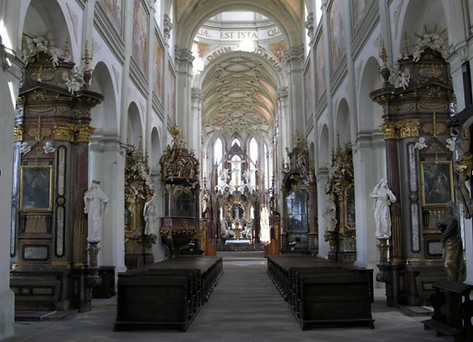
Our German Bohemian Legacy
by
Robert J. Paulson
GBHS Founder
Kladrau
The Convent was founded in 1115 by Duke Vladislav I and his wife Richenza from Berg from the river valley of Úhlavka in the West Bohemia during the Roman Catholic colonization in the surrounding residential area of West Slavic Choden. Benedictine monks from Swabia were settled with the proceeds from the subjugation of the peasant population under the feudal system… He also presented the monastery with land ranging from the Bohemian Aicha ( Cesky Dub) in northern Bohemia , the basic rule was sold by the Benedictines in 1234 . The traditional founding document of the monastery Kladrau from the year 1115 to a later end of the 12th His century, which served to provide a written account of the extensive manors of the monastery and its revenue.
During the attacks of the Hussites under the commander Andreas Prokop the Romanesque Basilica was burned in Kladrau and the monastery was plundered. In the 17th Century during the Counterreformation in Bohemia, the monastery, became a Roman Catholic place of pilgrimage for several years , which did not last, since the monastery was again destroyed in the Thirty Years' War . In the early 18th Century with the return of large estates the monastery was rebuilt. The abbey church that had been completely destroyed was rebuilt according to the plans of the Italian architect Jan Blazej Santini - Aichl. Completed in 1726, it became the most important building of the Baroque-Gothic style, more to interpret the humanities and religious studies than as a history of architecture, an interesting phenomenon within the Central European Baroque. It can be seen from s great distance because of the wooded surroundings. Inside there are numerous altars , choir stalls and pulpit. In 1726-27 Cosmas Damian Asam created the vault of the 83 meter long interior which is dominated by a high dome .
After the dissolution of the monastery in 1785 by the Josephinism in favor of the so called Religious Fund, the building served various purposes , they were hospital , barracks and military hospital. In 1825, Prince Alfred I. Windisch -Graetz , bought the monastery and the corresponding surrounding Estate for 275,500 gold pieces , a portion of the purchase price was use for a debt that had not been paid for his services to the monarchy of Austria - Hungary. In Kladruby a brewery was built in 1864 in the former monastic convent . In the revolutionary year of 1848 the serfdom of the villagers ended.
After the end of World War II, in the course of land reform in Czechoslovakia, the Prince Windisch -Graetz lost the main residence of the family in Tachou in western Bohemia. Ludwig Aladar of Windisch -Graetz moved to Kladrau , where he built an extensive library and a family archive. From 1938-1945 Kladrau belonged to the German Empire. In 1945, the total holdings of the family Windisch -Graetz was confiscated in Czechoslovakia. The former monastery Kladruby is now owned by the state and can be visited .





